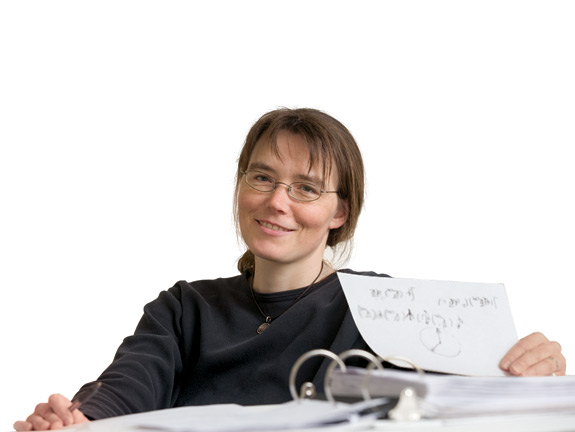Doerte Blume is good at explaining difficult concepts. She draws as she talks, putting into pictures what she knows about the tiniest fragments of matter. Her desk is swimming in paper, with notes and graphs and sketches of atoms lapping at the sides of her computer and spilling against a jetty of books. As a theoretical physicist, she relies heavily on high-powered math; but for her, before the math come the images.
Working solely from equations “doesn’t get me very far,” she says. “I also have to have the physical picture of, what would I expect? What do the particles do? I always try to think about, what physical mechanism is it that helps to formulate the equation I want to use?”
Blume is trying to understand the behavior of fermions (FUR-me-ons) and bosons (BO-zons), which is to say, the behavior of almost everything. Every particle in existence, from quarks and electrons up through atoms, is either a fermion or a boson. What makes a particle one or the other is a property called “spin,” which needn’t concern us here. What sends Blume’s imagination into high gear is what fermionic and bosonic atoms do when they get really, really cold.
Bosons lose energy as the temperature drops. If they get cold enough, they condense into a blob of matter called Bose-Einstein Condensate, or BEC, in which they all crowd into the lowest possible energy state. “That’s very, very characteristic of bosons,” says Blume. “They all want to do the same thing. It’s like bosons are social; they want to be together. Imagine a party, and you are in a conversation with a bunch of other people. The bosons, they would be that cluster.”
Fermions, on the other hand, want nothing to do with each other. “No fermion can be where another fermion is,” says Blume. “If one fermion occupies one energy state, the other fermion has to go to a different energy state.”
Even at temperatures near absolute zero (-273 degrees F.), fermions won’t bunch up in the lowest energy state. Instead of condensing like bosons, they form what’s called a degenerate Fermi gas. Since its fermions remain at fairly high energy levels, a Fermi gas has some unusual properties. Most notably, it may act like a superconductor.
Superconductivity is the transmission of electricity with no resistance. It’s like skiing downhill on ice. The current just goes. Superconducting crystals can be made in the lab, but so far the highest temperature at which they work is around -134 degrees F. Figuring out how to make superconductors that work at room temperature is one of the holy grails of modern physics and materials science.
The problem is, we don’t yet have a solid theoretical understanding of superconductivity, and without that, efforts to create superconductors tend to include a lot of trial and error.
“The theory of superconductivity is so hard,” says Blume. “Even if we can write down an equation, we might not be able to solve it, even with all the computer power there is.”
That’s where the ultra-cold fermion atoms come in. Experimental physicists have found that they can make a Fermi gas look and act like a crystal by using a grid of laser beams—an optical lattice—to slice and dice the gas so each atom ends up in its own little space.
“If you cut it open, it’s like an egg carton,” says Blume of an optical lattice. “You can put one atom per site in this egg carton. This is essentially a model for a typical crystal.”
In a crystal, electrons flow through the spaces between atomic nuclei that are rigidly bound to each other. In an optical lattice, whole fermionic atoms flow around the barriers created by the light beams. It’s a great model experimentally, because atoms are much easier to work with than electrons. It’s also a great model theoretically, because the equations describing their behavior can actually be solved.
Once Blume devises equations that describe a particular lattice, she uses them to do a theoretical experiment. What happens if she changes how strongly the particles interact with each other, or how much they attract or repel each other, or the size of the space they’re confined in? Sometimes an experimentalist asks her to try a variation on paper before tackling it in the lab. Other times, she suggests the experimentalist do for real what she did in theory.
“We can go ahead and do an experiment; go ahead and do a theory; and we can compare them pretty much without fudging,” she says. “If the results agree, it suggests we understand the physics. And if the results don’t agree, then we don’t understand the physics entirely… It would make me think and go back: Did I include all the right things? But I would also ask the experimentalist, ‘Are you sure your [set-up] was like this and not like that?’”
At WSU she shares ideas with fellow theorist Chuanwei Zhang and experimentalist Peter Engels, who was the first person in the Pacific Northwest to make an atomic BEC (see The Science Shop). Engels recently began working with Fermi gases and will soon launch a new series of experiments: He’s going to put fermions and bosons into an ultra-cold chamber at the same time.
Blume is sharpening her pencils in anticipation.
“Bosons are really interesting, fermions are really interesting—now what’s going to happen if you mix them?” says Blume. “The fermions don’t want to be on top of each other, but the bosons want to occupy the same space. But now the bosons can interact with the fermions, so does that make the fermions want to come closer?”
For Blume and her cold-matter colleagues, the party is just getting started.

